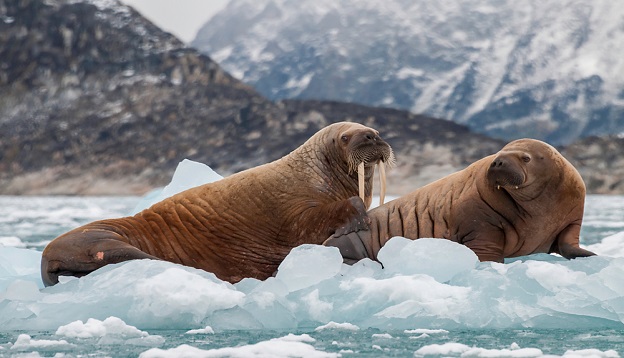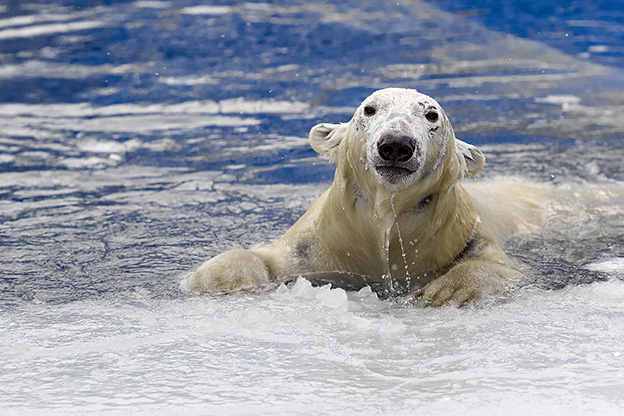Arctic Photography: 10 Essential Tips
Perfecting the art of Arctic photography – we share invaluable tips from our experts so you can make the most of your skills and your gear.
The Arctic may well be one of the most photographic destinations on earth although, much like Antarctica, it is also one of the most challenging. We’ve squeezed some valuable info from the experts and compiled a list of the top photography tips for the Arctic to help you capture those precious travel moments.
Here’s what you should know when heading north on an Arctic photography expedition:
1. The must-have basics: wide-angle lens, standard 50mm lens and 400mm zoom
If you’re reading this guide, we assume you’re looking to take more than your smartphone or a point + shoot along to the Arctic and this, we must say, is a very good idea. The basic set-up most photographers take along to the far north is a good DSLR body (preferably, two) along with a standard 50mm lens, a wide-angle lens and a 200 (minimum) or 400mm (ideal) zoom.
This basic kit will enable you to capture the startling beauty of the Arctic landscape and its incredible wildlife from afar and, in some rare occasions, close-up. Given you’ll need to keep a safe distance from all the animals that live up north (if not for your safety, at the very least for theirs) you’ll be making good use of your telephoto lens which is the reason a 400mm zoom is preferable to a 200.

2. Take advantage of onboard photography workshops
Many Arctic expeditions include onboard photography workshops with some expeditions being solely dedicated to the craft. This is ideal if you haven’t had any Polar experience yet and are unaware of the challenges of extreme (and extremely white) landscapes.
The Arctic is, without a doubt, one of the most unique (and challenging) photographic destinations on earth, the excessive glare undoubtedly the main issue for most inexperienced photographers. There are plenty of filters out there that’ll help mitigate glare and there are also techniques you can use to capture your subjects from the right angles, all of which you can learn in-situ if you haven’t had a chance to take a camera course before travelling here.
Moreover, do note that almost all Arctic expedition guides are experienced photographers of their own right so don’t hold back on asking questions and seeking guidance during your journey.
3. Practice handheld photography with your biggest zoom
Tripods can be a nuisance when travelling to the Arctic and can seriously restrict your movements on land. Who wants to lug that thing around? Unless you’re heading up in winter to catch the Aurora Borealis and planning to take plenty of long exposure shots, practice your handheld photography instead, the experts say, and you’ll relish the ability to move around freely.
4. Protecting your gear from the Arctic elements is your #1 mission
On an Arctic expedition, your main priority will be to keep your gear (and yourself) protected from the harsh elements. Bring some UV filters to save your precious lenses and include some silica absorption pads in with your gear to avoid a build-up of condensation.
Rather than bring one large padded bag (the suitcase kind that holds various parts), it’s better to pack each camera piece individually in its own padded bag, all packed in an easy-to-carry backpack. This helps you avoid exposing gear to the elements, unnecessarily – i.e. only open the bag of the specific equipment you need, at any given time.

5. Pack plenty of spares
Very cold temps can drain camera batteries faster than you can say ‘OMG is that a polar bear?!’ so always pack more than you think you’ll need. Moreover, it’s an excellent idea to keep your spares warm(er) by storing them in insulated bags on your person (the inner pockets of your fleece jacket are among the best battery storage spaces of all) when you’re meandering the great Arctic outdoors.
Given you will take an insane number of photos, it’s safe to say you can never bring too many spare SD cards either. You’ll have plenty of downtime aboard the ship to download and recharge every day but it’s great to know that you don’t have to, should you have a particularly active day out.

6. White on white – why polar bears can be the hardest to photograph
Set against a backdrop of blinding white light reveals polar bear fur to be a most definite light-beige colour, except this very slight colour discrepancy just doesn’t translate well, on film, on an exceptionally sunny day. Abundantly snowy landscapes can be difficult to photograph in the height of summer, especially so when you’re trying to capture light-coloured wildlife like polar bears and Arctic foxes.
Your options here are two: either you wait for the animal to move so it no longer has snow/ice on the background or you manoeuvre yourself to place the animal in front of a non-white background. The only other way to do solve a white-on-white background conundrum is to take a breathtaking close up of your intended subject.

7. Try to portray Arctic subjects to scale
The stunning Arctic wildlife and landscape are seriously oversized except that when photographed without anything relatable with which to compare, the grandeur can be easily overlooked. Clever photographers will try to use a knowable prop in the Arctic, be it a boat, kayak or even a person walking on land. If you can portray how big the animal/waterfall/iceberg is, relative to something else, the photo will be all the more impressive.

8. Don’t stress about the horizon – you’ll be moving around a lot!
It can be difficult to take a straight photo when you’re bopping around on a kayak, cruising on your ship or zooming away on a zodiac. Expert photographers know that time is of the essence in these situations (if you’re taking your camera lens off on a zodiac ride, it’s usually due to an amazing wildlife sighting) so they don’t even waste time trying to photograph with a straight horizon.
Instead, they take a much wider photo than they’d like to, intending to straighten and crop upon editing.
9. Practice patience – the best Arctic shots often come down to sheer good timing
From the dancing Aurora Borealis to a breaching humpback, a waddling penguin slipping on its belly or a polar bear popping up from the sea: some of the most amazing wildlife action shots in the Arctic are captured by sheer chance. Or at least, that’s how it may appear. In all likelihood, however, the photographer stood his/her ground and practised the art of patience, predicting a possible ‘gotcha’ moment.
And when that pays off…it does so big time.

10. Keep your expectations in check and enjoy the journey
Even the most professional and experienced Arctic photographer will go home with literally thousands of photographs, knowing well that just a handful will end up being ‘poster quality’ shots. This is the reason every expert will tell you to shoot with abandon, given that digital photography allows us to do just that, nowadays, quickly and inexpensively.
Above all, however, they’ll also tell you to simply enjoy the amazing adventure and the process of photographing this mesmerizing destination – even if none of your photos end-up being ‘National Geographic quality’.
Because, for you, they’ll be even more priceless than that.
At Chimu Adventures, we love taking avid photographers to the Arctic and showing them what a magnificent treasure of nature this place really is. We offer expeditions to Spitzbergen, Greenland and the Arctic regions of Canada as well as unforgettable jaunts to the North Pole.

Frequently Asked Questions
Q1. Do I need a zoom lens for Arctic cruise photography?
Any camera or smartphone can capture special memories, but for wildlife shots, you may prefer the versatility of a camera with a telephoto zoom lens.
Q2. How do I protect my photography gear on an Arctic cruise?
Most modern photography gear is wind and water resistant, but you’ll also want to ensure your equipment stays dry and is housed in padded cases onboard, ensuring it doesn’t get jostled around.
Q3. What can I photograph on an Arctic cruise?
Each Arctic destination will offer unique opportunities for photography, particularly wildlife, landscapes and glaciers, and colourful architecture.
Q4. Is an iPhone camera ok for Arctic cruise photography?
Whatever camera you have with you is best! But for more photography options, you may prefer the versatility of a DSLR or mirrorless camera.
Where Will You Go Next ?
- Popular Destinations
- Antarctica
- The Arctic
- South America
- Central America
- More to explore
- Amazon
- Antarctic Circle
- Antarctic Peninsula
- Argentina
- Bolivia
- Brazil
- Canadian Arctic
- Chile
- Colombia
- Costa Rica & Panama
- East Antarctica
- Ecuador
- Galapagos Islands
- Greenland
- Guatemala & Honduras
- Machu Picchu
- Mexico
- Patagonia
- Peru
- South Georgia and Falkland Islands
- Spitsbergen
- Sub Antarctic Islands

Talk to one of our experienced Destination Specialists to turn your Antarctic, Arctic and South American dream into a reality.
Contact us
